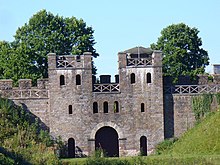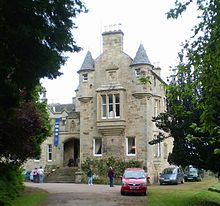Caer

Caer(Welsh pronunciation:[kɑːɨr];Old Welsh:cairorkair) is aplacename elementinWelshmeaning "stronghold", "fortress", or "citadel",[1]roughly equivalent to anOld Englishsuffix(-ceaster) now variously written as-caster,-cester,and-chester.[2][3]
Inmodern Welsh orthography,caer is usually written as aprefix,although it was formerly—particularly in Latin—written as a separate word. TheBretonequivalent iskêr,which is present in many Breton placenames as the prefixKer-.
Etymology
[edit]The term is thought to have derived from theBrittonic*kagro-and to be cognate withcae( "field, enclosed piece of land" ).[4]Although stonecastleswere largely introduced toWalesby the invadingNormans,"caer" was and remains used to describe the settlements around some of them as well. An example is theRoman fortatCaernarfon,formerly known in Welsh asCaer Seiontfrom its position on theSeiont;the laterEdwardiancastleand its community were distinguished asCaer yn Arfon( "fort in Arfon", the latter being a district name (Cantref Arfon) from "ar Fôn", "(land) opposite Môn orAnglesey").[2]However, the modern names of the Roman fort and Edwardian castle themselves are nowSegontiwmorCastell Caernarfon,while the communities carry on the namecaer.
Note that the term is not believed to be related to theIrishcathair( "city" ), which is instead derived fromProto-Celtic*katrixs,*catarax( "fortification" ).[5][6]
Britain
[edit]Gildas'saccountof theSaxon invasions of Britainclaimed that there were 28 fortified Roman cities (Latin:civitas) on the island, without listing them.[8]TheHistory of the Britonstraditionally attributed toNenniusincludes a list of the 28, all of which are called "caer".[7][12]Controversy exists over whether this list includes only Roman cities or a mixture of Roman cities and non-Roman settlements.[13]Some of the place names that have been proposed include:

- Cair Brithon ( "Fort of theBritons":DumbartoninStrathclyde[10][14])
- Cair Caratauc ( "Fort Rampart":Salisbury?[11]Sellack?[10])
- Cair Ceint ( "FortKent":Canterbury)
- Cair Celemion (Camalet?[16]Silchester?[10])
- Cair Colun ( "FortColonia":Colchester?[10][11])
- Cair Custoeint ( "FortConstantiusorConstantine":Caernarfon;[18]orposs.a Devonian hillfort[19])
- Cair Daun ( "FortDon":Doncaster)
- Cair Draitou (Drayton?[11]Dunster?[10])
- Cair Ebrauc ( "FortYork":York)
- Cair Grauth ( "FortGranta":Cambridge[20])
- Cair Guent ( "FortVenta":Caerwent[10]orWinchester[11])
- Cair Guinntguic( "FortVenta":Winchester?[10]NorwichorWinwick?[11])
- Cair Guiragon ( "FortWeorgoran":Worcester)
- Cair Guorthigirn ( "FortVortigern":Little Doward?[10]Carmarthen?[21])
- Cair Guricon (Warwick?[11]Wroxeter?[10])
- Cair Legeion Guar Usic ( "FortLegionon theUsk":Caerleon-upon-Usk)
- Cair Legion ( "FortLegion":Chester)
- Cair Lerion ( "FortLeir":Leicester)
- Cair Ligualid ( "FortLuguwalos":Carlisle)
- Cair Luit Coyt ( "FortGrey Wood":Wall[23])
- Cair Lundem ( "FortLondinium":London[24])
- Cair Maunguid (Manchester?)
- Cair Meguaid ( "FortMediolanum":Meifod?[10][11]Llanfyllin?[25]Caersws?[26]inPowys)
- Cair Mincip ( "FortMunicipium":St Albans)
- Cair 'Pensa vel Coyt' ( "FortPenselwood":[27]Exeter?[11]Ilchester?[10])
- Cair Peris (Porchester?[11][10]Builth Wells?[10])
- Cair Segeint ( "FortSeiont":Caernarfon;[10]orposs.Silchester[11])
- Cair Urnarc (Wroxeter?[11]Dorchester?[10])
Wales
[edit]

The elementcaer,sometimes anglicized ascar,is found in several place-names in Wales such as:
- Caerau,Glamorgan ( "Forts" )[28]
- Caereinion,Montgomeryshire ( "Fort on the Einion" )[29]
- Caerfallwch,Flintshire ( "Afallach's fort" )[29]
- Caerfarchell,Pembrokeshire ( "Marchell's fort" )[30]
- Carmarthen,Carmarthenshire (Caerfyrddin,"Merlin's fort" ).[31]
- Caergeiliog,Anglesey ( "Fort of the cockrell" )[32]
- Caergwrle,Flintshire ( "Fort of the crane-wood" )[33]
- Caerleon,Glamorgan (Caerllion,"FortLegion")
- Caernarfon,Caernarfonsire ( "FortArfon")
- Caerphilly,Glamorgan (Caerffili,"FortFfili")
- Caerrhun, Caernarfonshire ( "Fort of Rhun" )[29]
- Caersws,Montgomeryshire ( "Susan's fort" )[29]
- Caerwent,Monmouthshire ( "FortVenta")
- Cardiff,Glamorgan (Caerdydd,"FortTaf")
- Carew,Pembrokeshire[30]
- Gaerwen,Anglesey (Caerwen,"white fort" )[29]
- Holyhead,Anglesey (Caergybi,"FortCybi")
England
[edit]The Cumbric language was spoken in Northern England until the Medieval era in which the elementcaer( "fort" ) was used in naming places.[34]It also appears in Cornish place-names asKer-.[34]
- Caermote,Cumberland (Caermollt,"Fort of the wether" )[34]
- Cardew, Cumberland (Caerdu,"Black fort" )[34]
- Cardunneth, Cumberland (Caerdunawd,"Dünǭd's fort" )[34]
- Cardurnock,Cumberland (Caerdwrnog,"Fort of the fist-sized stones" )[34]
- Cargo,Cumberland (Caergoll,"Fort of hazel" )[34]
- Carhullan, Westmorland ( "Fort of Holland" )[34]
- Carrick, Northumberland (Caerwig,"vicus fort" )[34]
- Carlatton, Cumberland ( "Fort of the leek enclosure" )[34]
- Carlisle,Cumberland (Caerliwelydd,"FortLuguwalos")[34]
- Carmolt, Cumberland (Caermollt,"Fort of the wether" )[34]
- Carrycoats,Northumberland (Caerycoed,"Fort of the wood" )[34]
- Carvoran,Northumberland (Caerferin,"Fort of the Morini" )[34]
- Kerrier,Cornwall[35]
Caeris also found in Welsh exonyms for English cities.
- Cambridge(Caergrawnt,"FortGranta")
- Canterbury(Caergaint,"FortKent")
- Chester(Caer,"Fort" )
- Chichester(Caerfuddai )
- Durham(Caerweir,"Fort of theWear")[34]
- Gloucester(Caerloyw )
- Exeter(Caerwysg,"FortUsk",also CornishKaresk)
- Lancaster(Caerhirfryn )
- Leicester(Caerlŷr,"FortLeir")
- Lichfield(Caerlwytgoed,"FortGrey Wood")
- Salisbury(Caersallog )
- Winchester(Caerwynt )
- Worcester(Caerwrangon )

Scotland
[edit]CumbricandPictishwere Brittonic languages spoken in Scotland until around the 12th century, andcaer( "fort" ) was a place-naming element in both languages.[34][36]
- Caerketton, Midlothian ( "Fort of Catel" )[34]
- Caerlanrig,Roxburghshire (Caerllanerch;"Fort Clearing" )[34]
- Caerlaverock,Dumfriesshire ( "Fort of Llywarch" )[34]
- Carcluie,Ayrshire ( "Fort of Clewein" )[34]
- Carden, Fife. FormerlyCardenni[36]
- Cardonald,Renfrewshire ( "Duμnwal's fort" )[34]
- Carleith, Dunbartonshire[34]
- Carmichael,Lanarkshire ( "Fort of Saint Michael" )
- Carmuirs, Stirlingshire[34]
- Carmurie, Fife ( "Fort of the Sea" )[36]
- Carmyllie,Angus ( "Fort of the warrior" )[37]
- Carpow,Perthshire (Caerpwll;"Fort of the sluggish stream" )[36]
- Carriden,West Lothian ( "FortEidyn")
- Carruthers,Dumfriesshire ( "Fort of Rhodri" )[34]
- Carstairs,Lanarkshire ( "Fort of the Tarras" )[34]
- Crail,Fife ( "Fort of the rock" )[36]
- Cramond,Midlothian ( "FortAlmond")
- Kair, Kincardineshire ( "Fort" )[37]
- Keir, Aberdeenshire ( "Fort" )[37]
- Keir,Dumfries-shire ( "Fort" )[34]
- Keir, Stirlingshire ( "Fort" )[38]
- Keirhill, West Lothian[34]
- Keirs, Ayrshire[34]
- Kirkbuddo,Angus ( "Fort of Buiteoc" )[38]
- Kirkcaldy,Fife (Caercaledin;"place of the hard fort" or "place of Caled's fort" )[39]
- Kirkintilloch,Dunbartonshire. FormerlyCaerpentaloch[34]
In fiction
[edit]- Caer Bocram from the video gameTales of Vesperia
- Caer Bronach and Caer Oswin from video gameDragon Age: Inquisition
- Caer Cadarn from the novel seriesThe Warlord Chronicles- set inCadbury Castle, Somerset,according to the author's note inThe Winter King.[citation needed]
- Caer DallbenfromThe Chronicles of Prydainnovel series
- Caer Darrow from the video gameWorld of Warcraft
- Caer Dhú from the novelThe Sword of Rhiannon
- Caer Llyr and Caer Secaire from the novelThe Dark World
- Caer Lyon from the video gameWizard101
- Caer Siorai from the video gameDeath's Gambit
- Caer Xhan from the video gameBreath of Fire III
- Cair Paravelfrom theChronicles of Narnianovel series
- Kaer Morhen and Kaer Trolde fromThe Witchernovel series
- Kaer Norvent from the video gameFinal Fantasy XVI
- Kêr-Is(Ys), ofBreton legend
- Kerrith, town mentioned in the novelRebecca,set in Cornwall
- TheRabbit of Caerbannogfrom the filmMonty Python and the Holy Grail
See also
[edit]References
[edit]- ^Carlisle, Nicholas.Topographical Dictionary of the Dominion of Wales,"Glossary", p. xxx.W. Bulmer & Co. (London), 1811.
- ^abcAllen, Grant."Casters and Chesters" inThe Cornhill Magazine,Vol. XLV, pp. 419 ff.Smith, Elder, & Co. (London), 1882.
- ^More precisely, these English placename elements derive fromLatincastrum( "fortified post" ) and its plural formcastra( "military camp"), making them the more precise equivalent of the Welshcastell.
- ^Geiriadur Prifysgol Cymru,vol. 1, p. 384.
- ^Ebel, Hermann Wilhelm (April 6, 2001).The Development of Celtic Linguistics, 1850-1900: Celtic studies.Taylor & Francis.ISBN9780415226998– via Google Books.
- ^Stifter, David (June 12, 2006).Sengoidelc: Old Irish for Beginners.Syracuse University Press.ISBN9780815630722– via Google Books.
- ^ab"JTK"."Civitas" inCeltic Culture: A Historical Encyclopedia,Vol. I, p. 451.ABC-CLIO (Sta. Barbara), 2006.
- ^De Excidio Britanniae,§ 3.(in Latin)Cited in the "Civitas" entry ofCeltic Culture.[7]
- ^abNennius(attrib.).Theodor Mommsen(ed.).Historia Brittonum,VI.Composed after AD 830.(in Latin)Hosted atLatin Wikisource.
- ^abcdefghijklmnopqrsFord, David Nash. "The 28 Cities of BritainArchived2016-04-15 at theWayback Machine"at Britannia. 2000.
- ^abcdefghijklmnopqNewman, John Henry & al.Lives of the English Saints: St. German, Bishop of Auxerre,Ch. X: "Britain in 429, A. D.", p. 92.Archived2016-03-21 at theWayback MachineJames Toovey (London), 1844.
- ^Latin names according toMommsen's edition ofNennius,[9]translations and modern equivalents according toFord,[10]Ussher,[11]or as otherwise noted.
- ^Breeze, Andrew."Historia Brittonum" and Britain's Twenty-Eight Cities atJournal of Literary Onomastics.2016.
- ^Bishop Ussherargued forBristol.[11]
- ^Cited in Frank Reno'sThe Historic King Arthur: Authenticating the Celtic Hero of Post-Roman Britain,Ch. 7: "Camelot and Tintagel", p. 201.
- ^Usser,[11]followingJohn Leland.[15]
- ^On page 20 of Stevenson's 1838 edition of Nennius's works.
- ^Bishop Usshercites another passage in Nennius:[17]"Here, says Nennius,ConstantiustheEmperor(the father probably ofConstantine the Great) died; that is, near the town ofCair Segeint,or Custoient, inCarnarvonshire".Nennius stated that the emperor's inscribed tomb was still present in his day.[11]Fordcredits this to Constantine, son ofSaint Elen.[10]
- ^PerFord,who ascribed Nennius's "Caer-Custoeint" to one of theDumnoniankings namedConstantine.[10]
- ^Although note thatBishop Ussherascribed this to theCambridgeinGloucestershire.[11]
- ^Veprauskas, Michael."The Problem of Caer Guorthigirn" atVortigern Studies.1998.
- ^InAcademy,Vol. XXX, Oct. 1886.
- ^Henry of Huntingtonpreviously ascribed it toLincoln,which was followed until the 19th century, whenBradleyplaced it atLichfield,[22]thinking it to be the RomanLetocetum.Instead, excavations have shown that Letocetum was located at nearbyWallinstead.[10]
- ^Both Ussher and Ford use the transcriptionLundein;with regard to Mommsen, note the similarity withLindum,the Roman name for present-dayLincoln,and the genericname*Lindon,"lake".
- ^Williams, Robert."A History of the Parish of Llanfyllin" inCollections Historical & Archaeological Relating to Montgomeryshire,Vol. III, p. 59.J. Russell Smith (London), 1870.
- ^Roman Britain Organisation."Mediomanum?" atRoman BritainArchived2007-04-01 at theWayback Machine.2010.
- ^Coitis Welsh for "woods" or "forest".Fordtakes the name as a single construction "Caer-Pensa-Uel-Coyt" ( "FortPenselwood"), whileMommsenandUsshertreatvelas theLatinword foror:"Cair PensaorCoyt ".[9][11]
- ^Deacon, Thomas (29 May 2020)."How the suburbs of Cardiff got their names".Wales Online.Retrieved15 May2021.
- ^abcdeMorgan, Thomas (1912).The Place-Names of Wales(Second and revised ed.).Retrieved16 May2021.
- ^ab"Place Names".Retrieved15 May2021.
- ^.Encyclopædia Britannica.Vol. 5 (11th ed.). 1911. p. 355.
- ^Jones, Gwilym; Roberts, Tomos (1996).Enwau Lleoedd Môn: The Place-Names of Anglesey.Bangor, Wales: University of Wales Press. p. 122.ISBN0-904567-71-0.
- ^Owen, Hywel Wyn (15 February 2015).The Place-Names of Wales.University of Wales Press.ISBN9781783161669.Retrieved15 May2021.
- ^abcdefghijklmnopqrstuvwxyzaaabacJames, Alan."The Brittonic Language in the Old North"(PDF).Scottish Place Name Society.
- ^A. D. Mills,A Dictionary of British Place Names(Oxford: Oxford University Press, 2011), s.v.
- ^abcdeSimon, Taylor; Markus, Gilbert (2006).The Place-names of Fife(Illustrated ed.). Shaun Tyas.ISBN9781900289771.
- ^abcWatson, W.J.; Taylor, Simon (2011).The Celtic Place-Names of Scotland(reprint ed.). Birlinn LTD.ISBN9781906566357.
- ^abHall, Mark A; Driscoll, Stephen T; Geddess, Jane (11 November 2010).Pictish Progress: New Studies on Northern Britain in the Early Middle Ages.Brill.ISBN9789004188013.Retrieved30 June2019.
- ^"Fife Place-name Data:: Kirkcaldy".fife-placenames.glasgow.ac.uk.
